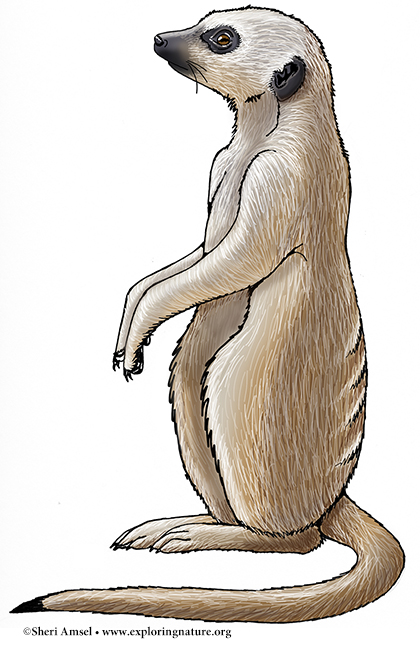

They are found in Africa.
They live on dry grasslands.
They are long, slender mammals reaching about 2 feet including the tail and weighing up to about 1.5 pounds. They are grayish-tan colored with some dark bands across the back. They have a long, thin tail with a black tip. They have a pointed face with dark eyes and small, dark ears. Their feet have sharp claws for digging.
They are active during the day (diurnal), living in social groups of up to 30 animals in underground burrows. These groups, called packs, are made up of many family groups, each with a mated pair (father and mother) and many offspring (kits). They find safety in numbers and take turns posting sentries that watch for danger. If danger approaches, they bark an alarm call to warn the others.
They eat mostly insects, but also some spiders and other invertebrates, like centipedes. They will also eat small lizards and birds.
They are killed by snakes, hawks, eagles and jackals.
Females are pregnant for 11 weeks (gestation) and have an average of 3 babies. They nurse for up to 2 months. Babies are often cared for by their fathers and other non-breeding members of the pack while the mother feeds.
They can live for more than 10 years in the wild but face many dangers, like poisonous snakes, that result in much shorter lives. They are Lower Risk - Least Concern on the IUCN List.
Kingdom: Animalia
Phylum: Chordata
Subphylum: Vertebrata
Class: Mammalia
Order: Carnivora
Suborder: Feliformia
Family: Herpestidae
Genus: Suricata
Species: S. suricatta
When you research information you must cite the reference. Citing for websites is different from citing from books, magazines and periodicals. The style of citing shown here is from the MLA Style Citations (Modern Language Association).
When citing a WEBSITE the general format is as follows.
Author Last Name, First Name(s). "Title: Subtitle of Part of Web Page, if appropriate." Title: Subtitle: Section of Page if appropriate. Sponsoring/Publishing Agency, If Given. Additional significant descriptive information. Date of Electronic Publication or other Date, such as Last Updated. Day Month Year of access < URL >.
Amsel, Sheri. "Meerkat" Exploring Nature Educational Resource ©2005-2024. December 14, 2024
< http://www.exploringnature.org/db/view/Meerkat >


